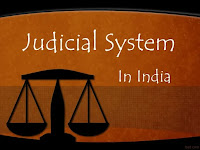This
article will be discussing about the Justice delivery system in India i.e., Judicial
System in India
INTRODUCTION:
Independence
of Judiciary is the basic feature of the Constitution of India. An independent
and impartial judiciary with the power of judicial review has been established
under the Constitution of India. The Supreme Court of India is apex judicial
institution in the country. There are High Courts for every States and other
Courts subordinate to the High Courts.
The
Indian Judiciary administers a common law system of legal jurisprudence, in
which customs, precedents and legislation, all form part of the law of the land.
The Constitution of India is the supreme legal documents.
There
is a hierarchy of courts with the Supreme Court at top which is the final Court
of adjudication for the entire country. Each State has its own High Court, but
the High Court judges are appointed by the President of India. The State
Judiciary is under the High Courts. The various types of Courts are as follows:
-
SUPREME
COURT OF INDIA:
The
Supreme Court of India is the apex court of the country based at New Delhi
which was established on 28 January 1950. It replaces the federal Court of
India, which was the apex of the Indian Judicial System at that time.
The
Supreme Court of India is established in accordance with the provisions
contained in Article 124 of the Constitution of India. It is the final
interpreter and guardian of the Constitution and also the guardian of the
Fundamental Rights of the people.
The
Supreme Court consists of Chief Justice and of other judges appointed by the
President of India. The number of the judges of the Supreme Court may vary, in
accordance with the law made by the Parliament in this regard. A judge of
Supreme Court can hold office till he attains the age of 65 years.
The
Supreme Court of India has its original jurisdiction with respect to matters
concerning enforcement of fundamental rights guaranteed under Part III of the
Indian Constitution. The Supreme Court has the powers to issue directions,
orders and writs for the proper enforcement of fundamental rights.
Mainly
five kinds of writs are issued for enforcement of fundamental rights. The
Supreme Court can issue various writs but usually the Supreme Court issues the
following types of writs: -
· Habeas Corpus – Habeas Corpus is a Latin term which literally means “You should have the body”. This writ is issued to produce a person who has been detained, whether in prison or in private custody, before a Court and such person may be released if his detention found to be illegal. A writ of Habeas Corpus may be filed by the person detained or by any other person on his behalf.
Mandamus
– Mandamus is a Latin word which means “We command”. This is an order issued by
the High Court to a Court or public authority to perform a public or statutory
duty. A writ of mandamus is issued to compel a public official or a public body
to perform a public statutory duty which it may have failed to perform.
Prohibition
– A writ of prohibition means an order to stop from doing anything. A writ of
prohibition is generally issued by the Supreme Court or by the High Court to
any inferior Court or statutory authority prohibiting the authority to stop the
proceedings. The give an example, if some statutory body is carrying out of
some work, such as mining or blating without requisite permission, the High
Court or the Supreme Court can issue a writ of Prohibition.
Certiorari
– Literally Certiorari means to be certified. This writ is issued by a
constitutional Court when the Court is of the opinion that any order passed or
proceedings carried out by the public authority or the State are not in
accordance with the law and it is, therefore, necessary to quash such order or
proceedings which are against the law. A writ of Certiorari will lie only
against the State or public authorities but not against a private person.
Quo
Warranto – The word Qua Warranto means “What is your
authority”. A Court is entitled to examine whether a person who is holding a
public office is qualified to hold such office and has been validly appointed
to hold such office. This kind of writ is issued with a view to restrain a
person from holding a public office to which he is not entitled. If a person
has usurped a public office, such writ can be issued directing him not to carry
out any activities in the office.
HIGH
COURT OF STATES:
Article
214 of the Indian Constitution provides that there shall be a High Court for
each State. The High Court has very wide constitutional powers under Article
226 of the Indian Constitution. The High Court like the apex court is also empowered
to issue writs, orders, or directions. The basic difference is that whereas
under Article 32 of the Constitution the Supreme Court can issue a writ, order
or direction only to prevent the violation of fundamental rights, under Article
226, the High Court has wider powers and can issue such writs not only for the
enforcement of the fundamental rights but also for any other purpose. The power
of the High Court is in that sense wider than the power of the Supreme Court.
The High Court is the highest judicial court of the State and the subordinate
judiciary is under the control of the High Court. The High Court also has the
power of superintendence over all Courts and Tribunals falling within its
jurisdiction.
THE
DISTRICT JUDICIARY:
The
District Judiciary does not deal with constitutional functions and issues like
the Supreme Court or the High Courts. They deal with the disputes which are
Civil and Criminal in nature. The District Judiciary can be categorized as
follows: -
Civil
Courts:
- Ø District
Judge
- Ø Additional
District Judge
- Ø Civil
Judge, Senior Division
- Ø Civil
Judge, Junior Division
Civil
Courts are empowered to adjudicate in disputes of civil nature, like money
disputes, boundary disputes, land disputes in respect of properties like
ownership and title, partition, contractual disputes etc. Civil Courts have
very wide jurisdiction and can entertain any civil dispute unless otherwise
specially barred by law.
Criminal
Courts:
- Ø Sessions
Judge
- Ø Additional
Sessions Judge
- Ø Assistant
Session Judge
- Ø Chief
Judicial Magistrate
- Ø Judicial
Magistrate 1st Class
- Ø Judicial
Magistrate 2nd Class
Criminal
Courts are entrusted with adjudication of disputes of criminal nature, especially
with respect to offences committed against human body, property, economic
offences, statutory offences etc. Murder, causing hurt, cheating, theft,
robbery, rape etc. are the various example of criminal offences. Some criminal
offences have been created under special statutes. Therefore, ragging is also a
criminal offence, employment of children below 14 years as laborer is a criminal
offence, denying maintenance to children or parents, violation of traffic
rules, smoking in public places, driving vehicle after consumption of alcohol,
riding two wheelers without wearing helmets are examples of criminal offences.
Family
Courts:
Family
Courts under District Judiciary mainly deal with matrimonial disputes and
disputes relating to custody of children etc. and these Family Courts have both
civil and criminal powers. The Family Courts are presided over by officers of
the rank of District Judge or Additional District Judge.
Revenue
Courts:
It
deals with revenue matters. The District Magistrate and Collector presides over
the District Level Revenue Courts.
Tribunals:
Besides
the same, there are also some Tribunals such as Commissioner, Employees
Compensation, Motor Accident Claim Tribunal, Land Acquisition Judge etc. and
those are presided over either by District Judges or by Additional District
Judges.
Lok
Adalats:
For
resolution of disputes through amicable settlement, there is a provision for
constitution of Lok Adalats and Permanent Lok Adalats under the provision of
the Legal Service Authorities Act, 1987. The Permanent Lok Adalat can take
cognizance of disputes relating to Public Utility Service in respect of
transport, postal, telegraph or telephone service, supply of water or light,
system of public conservancy or sanitation, service in hospital or dispensary
or insurance service at pre-litigation stage: provided that any matter relating
to any offence not compoundable under any law can not be brought to the Lok Adalats
or Permanent Lok Adalats. Disputes, the value of which exceeds Rs. One crore
also cannot be decided by the Permanent Lok Adalats.
Every
award of the Lok Adalats becomes binding on the parties and no appeal lies to
any Court against such award.
Alternative
Dispute Resolution (ADR):
Alternative
Dispute Resolution is a mechanism, evolved in the recent past, for resolution
of disputes outside the realm of Courts. It is a system of dispute resolution
going beyond the long practiced adversarial system of adjudication. There are different
kinds of methods of such dispute resolution. Section 89 of the Code of Civil
Procedure was comprehensively amended and introduce four systems of ADR which
are as follows –
Arbitration:
-
Arbitration is an adjudicatory dispute resolution processed by a Private Forum,
governed by the provisions of Arbitration and Conciliation Act, 1996. Reference
of any case to arbitration can only be made, if the parties agree to go for arbitration
and hot otherwise. When a matter is referred to arbitration, it goes out of the
stream of the Court process.
Conciliation:
-
Conciliation is a non-adjudicatory ADR process, which is also governed by the
provisions of Arbitration and Conciliation Act, 1996. There can be a valid
reference to conciliation, only if both the parties to the dispute agree to
have negotiations with the help of a third party either by an agreement or by
the process of invitation and acceptance provided in Section 62 of the said Act
followed by appointment of conciliators. If both parties do not agree for
conciliation, there can be no conciliation. In contrast to arbitration, when a matter
is referred to conciliation, the matter does not go out of the stream of court
process permanently. If there is no settlement, the matter is returned to the
court for proceeding with the trial.
Judicial
settlement including settlement through Lok Adalats: -
Judicial Settlement is a term by which settlement of a civil case is arrived at
on negotiation with the help of a judge who is not assigned adjudicate upon the
dispute. The Judge to whom the case is assigned, should not make any attempt for
judicial settlement to avoid any apprehension of bias or prejudice. In Lok Adalats,
cases are referred similarly for arriving at a settlement through negotiation by
the conciliator and accordingly, order are passed by the Presiding Judges.
Mediation:
-
Settlement by ‘Mediation’ means the process by which a mediator appointed by
the parties or by the court, as the case may be, mediates the dispute between parties
directly or by communicating with each directly or through the mediator. The role
of the mediator is to assist parties in identifying issues, reducing misunderstanding,
clarifying priorities, exploring areas of compromise, generating options in an
attempt to solve the dispute and emphasizing that it is the party’s own responsibility
for making decisions which affect them.
CONCLUSION:
For
the effective and smooth working of the democracy, an independent and impartial
judiciary is the essential requirement. The system should be made more
efficient and less time-consuming to enable it to administer justice rightly
and quickly.



.png)
.png)

No comments:
Post a Comment